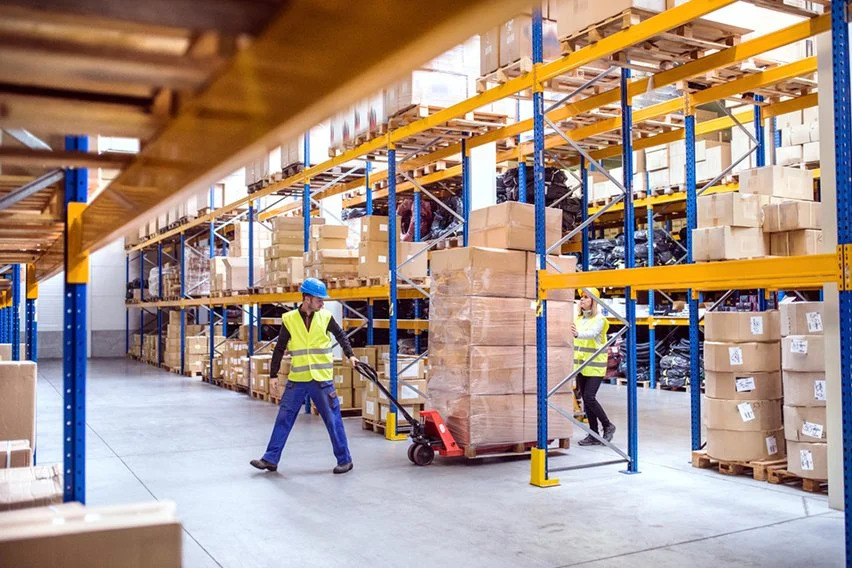Warehouses play a vital role in business operations. They serve as central hubs where goods are stored, sorted, and dispatched to meet customer demands. So, it’s crucial to organize them well. A neatly organized warehouse makes finding things quickly and getting orders out on time easier.
If you want to streamline your warehouse operations and improve efficiency, you’ve come to the right place. Below are practical strategies and best practices to help businesses maximize space utilization, streamline workflows, and enhance overall efficiency
Design an Efficient Floor Plan for the Best Workflow
Ensuring your warehouse layout is right is important for things to work well. It’s like the base for everything else that happens in the warehouse. Start by looking closely at how you’re currently using the space. See if any areas could be working better or causing problems.
Once you understand how things are set up, try to arrange them in a way that makes the most sense. Put shelves, work areas, and other stuff where needed most to avoid wasted space and make it easy to move around.
Additionally, think about how goods move through your warehouse. Make sure there aren’t any obstacles that could slow things down. And make sure the stuff that gets used a lot is easy to reach. Also, put areas like where you receive shipments and where you ship stuff out close together to make things go faster.
Select Shelving and Storage Solutions
Having the proper shelving and storage solutions is critical when organizing your warehouse. Investing in high-quality shelving and storage equipment can significantly affect how efficiently your warehouse operates.
Consider getting durable industrial workbenches. These provide sturdy surfaces for tasks like packing orders or doing inventory checks. Your employees can work more comfortably and efficiently with an excellent industrial work bench.
When choosing shelving units, look for ones that are adjustable and space-saving. This way, you can customize the shelves to fit the size and shape of your inventory and make the most of your available space. It’s also a good idea to choose shelving units suitable for different types of inventory, whether small parts, large boxes, or oddly shaped items.
Stay Organized with Labels and Signage
Labeling inventory and work zones throughout your warehouse is essential for maintaining long-term organization and efficient facility flow. Clear labels ensure that employees know exactly where to find items and where they belong. It’s particularly beneficial for new hires or facilities frequently using temporary labor.
However, the importance of labeling extends beyond inventory and work zones. Safety should always be a top priority in any warehouse environment. Therefore, it’s crucial to include signage for hazards, restricted areas, or other potential safety risks.
Clear and prominent signage helps to alert employees to potential dangers and reinforces safety protocols, reducing the risk of accidents or injuries.
Regularly maintaining labels and signage is essential to ensure their effectiveness over time. As inventory changes and operations evolve, labels may need to be updated or replaced to reflect current inventory and procedures accurately. Similarly, signage for safety hazards should be regularly inspected and refreshed to remain visible and legible.
Classify Inventory
Categorize your inventory based on how often items are needed, their size, and frequency. It helps you understand which items are in high demand and should be easily reachable and which are slower-moving and can be stored in less convenient spots.
For example, products that fly off the shelves should be placed in areas where they’re quick to grab, cutting down on time spent searching for them. On the flip side, items that aren’t used as often can be tucked away in spots that aren’t as easy to get to.
Establishing a systematic classification system for your inventory guarantees that everything has a proper place. This, in turn, expedites and simplifies the process for workers to locate the items they require, whether it be for order fulfillment or restocking shelves.
Reduce Clutter
Clutter can be a real problem in warehouses. It gets in the way of work and can even be dangerous. That’s why it’s essential to keep things tidy.
One way to tackle clutter is using storage solutions like bins, racks, and shelving. These help keep items off the floor and neatly organized, making it easier to find and access things when needed. Plus, they free up valuable floor space, making your warehouse feel more open and less cramped.
It’s also essential to encourage employees to do their part in keeping the warehouse clean and clutter-free. Remind them to clean up spills promptly, dispose of packaging materials responsibly, and return tools and equipment to their designated spots when they use them.
Final Takeaway
Efficient warehouse organization isn’t a one-time task—it’s an ongoing effort that requires careful planning and constant attention. But by following the strategies outlined in this guide, you can make a big difference in how smoothly your warehouse runs. It’s not just your business that benefits from a well-organized warehouse. Your customers will also notice the difference, with faster order fulfillment and fewer mistakes.











